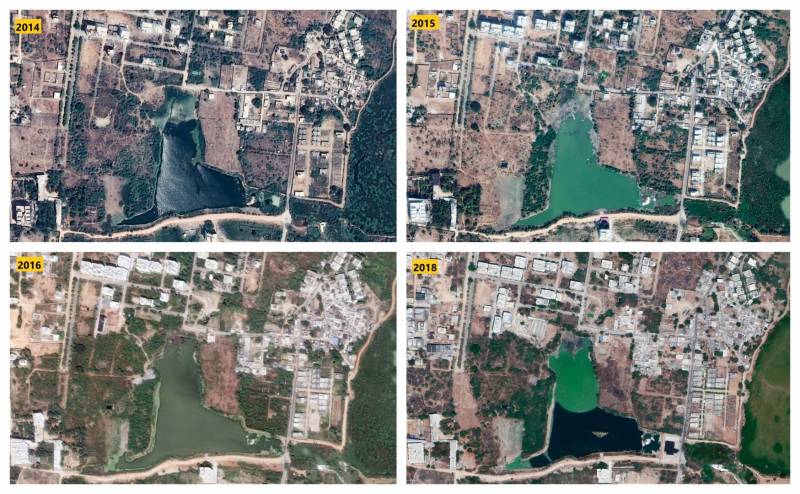A view from the satellite: The revival of Ibrahimbagh lake at the cost of River Musi
By Dheeshma
Hyderabad: The last of the lakes built by Ibrahim Qutb Shah, Ibrahimbagh lake was once home to many aquatic lives and was an abode of crystal-clear water. Over the years, due to untreated sewage disposal and encroachments, the lake faced severe pollution and began to die. This is evident from the satellite images that trace the lake’s journey from 2003 to 2019.
Coming to the present situation, thanks to the efforts of some city organisations, the lake is reviving. However, this revival comes at a high cost. While saving water bodies should be a priority to many cities, the process shouldn’t become a vicious cycle. Here in Hyderabad, the efforts to preserve and revive Ibrahim Cheruvu come at the cost of shifting all of latter’s problems to River Musi.

When Durgam Cheruvu and Malaka Cheruvu were revived from the state of being a drainage destination, the entire drainage water from Durgam Cheruvu was converted to Ibrahim Lake. The latter was, until then, a drinking water source. As and when Manikonda and Laknapuram areas started developing residential space, the drainage water from nearby colonies also started flowing into Ibrahim Lake. The volume of sewage coming from nearby settlements was significantly lower than the sewage waste diverted from areas like Banjara Hills, Jubilee Hills, and Film Nagar. It put the graph high in terms of sewage and water pollution. The lake dried with no aquatic life and lost most of the water bodies in its network.
Sunil Chakravarthy, an environmentalist and volunteer of Rally for Rivers, told NewsMeter, “We conducted several brainstorming sessions to develop sustainable solutions to revive the lake. We made sure to involve all the communities built around the lake, as they are all accountable for this particular lake.”
Several activities like Women’s Day celebration, Kite race and 5K run were conducted involving communities around the lake. Slowly, communities were engaged in cleaning and reviving the lake.

“During summers, the problem was significantly more serious. When the water level is low, there was no option for the sewage dumped into the lake to flow. It leads to an increase in mosquito population and pollution of groundwater,” Sunil added.
With long-term persuasion, the government finally allotted Rs 22.5 crore for reviving Ibrahimbagh Lake. Sunil said, “Our idea is to divert the entire sewage into Musi River. The sewage treatment plant doesn’t work for any lakes in the city. The one at Durgam Cheruvu is also not giving any result. We have no other option but to divert the sewage into Musi. Right now, it is in progress.”
Untreated water is the most significant source of water hyacinth. One semi-lake infected with water hyacinth can have severe environmental impacts, including clogging the water inflow. With about three months of labour, the communities near Ibrahimpur have managed to remove water hyacinth in the lake.
Another major issue, which is killing Ibrahimbagh Lake, is the illegal burial grounds build in the water spread areas of the lake. Though the number of incidents has come down over the years, there is no action from authorities to block the construction of cemented graves.
“Whenever the water level in the lake comes down, people come with bodies for burial. So our worry is in case of heavy rains whether these bodies will submerge in the lake,” Sunil added.